The March quarter 2000 National Accounts confirmed the continued strong performance of the Australian economy. GDP growth of 1.1 per cent was recorded in the quarter and 4.3 per cent through the year. This constituted the twelfth consecutive quarter of through-the-year growth of 4 per cent or above; an outcome not seen for almost three decades.
Recent indicators suggest that economic growth is likely to have remained solid in the June quarter. While the underlying trend in retail trade growth slowed over the first half of 2000, the strong rise in retail trade in the month of June (due mainly to the bring forward in spending in the lead up to the introduction of The New Tax System) is likely to have contributed to solid consumption growth in the June quarter. Moreover, robust employment growth in the June quarter and the month of July is likely to be indicative of ongoing strength in underlying economic activity.
Despite the continued strong GDP outcomes and employment growth, ongoing inflationary pressures have remained in check. Taken together, the various measures of wages growth indicate only limited upward pressure on prices through higher wage outcomes. While the CPI increased by a little over 3 per cent through the year to the June quarter, this largely reflected higher world oil prices indicating that ongoing inflation was significantly lower than the headline rate.
Looking further ahead, Australia’s GDP growth in 2000-01 is forecast in the Budget to be 3 per cent. Some moderation in domestic demand is likely through reduced consumption growth and a decline (albeit from very high levels) in dwelling investment. This is likely to be partially offset by a solid outlook for business investment and the beneficial impact on net exports from the lower exchange rate and the continued above trend growth in the world economy.
Developments in the World Economy
World economic growth over the first half of 2000 remained strong, generally in line with Budget forecasts. While growth in the US economy was very rapid in the first half of 2000, it is expected to moderate over the course of the year. European activity remains firm and the Asian economic recovery has continued on the back of the strong recovery over 1999. The Japanese economy, which has been underperforming in recent years, is showing signs of a moderate, albeit fragile, recovery.
Over the medium term, world economic growth is expected to decline a little but remain above its longer-term average (Chart 1) as activity in the US moderates, the Asian region settles around more sustainable rates of growth and European economic growth stabilises. As a partial offset, growth in the Japanese economy is expected to be a little stronger than in past years.
Chart 1: World GDP growth rates(a)
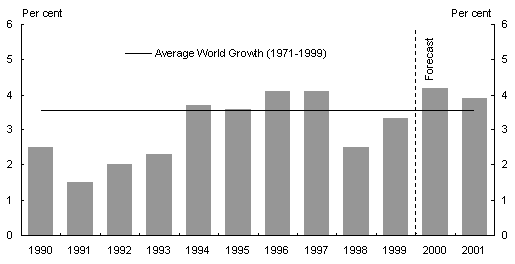
(a) World GDP growth rates are calculated using GDP weights based on purchasing power parity.
Source: Various national statistical publications, International Monetary Fund (IMF) and Treasury.
There remains a number of key uncertainties around the outlook, including: the extent of the moderation in the US economy; whether the Japanese economic recovery can be sustained; and whether Asia can maintain the momentum of structural reform necessary to sustain high rates of growth.
The US continues to set new records as it enters its tenth consecutive year of economic expansion. Preliminary data for the June quarter pointed to economic growth at an annualised rate of 5.2 per cent and the unemployment rate continues to hover around 4 per cent, the lowest level since the end of the 1960s.
Productivity in the US has continued to grow strongly over recent years, rising 5.1 per cent through the year to the June quarter 2000 compared with the revised March quarter estimate of 3.9 per cent growth through the year. This has helped to contain labour costs, with inflationary pressures therefore building only gradually. Although consumer prices are currently increasing at an annual rate of 3.7 per cent, this has been significantly affected by the recent surge in energy prices, particularly petrol. Core inflation, which excludes food and energy, remains steady at around 2.4 per cent and there have been recent signs that world crude oil prices have peaked, which should help to moderate headline inflation in coming months.
Consumer spending (particularly on motor vehicles) and the housing market have come off recent highs. While the recent preliminary June quarter 2000 GDP release showed private consumption moderating, consumer confidence increased in July. Business investment growth is expected to remain robust with continuing strong external and domestic demand, although it may moderate if the recent easier trend in consumption growth is sustained.
In Japan, seasonally adjusted GDP rose 2.4 per cent in the March quarter, underpinned by private consumption, business investment and net exports. Nevertheless, GDP in the quarter was only 0.7 per cent above year-earlier levels, reflecting the decline in activity over the second half of 1999. Despite the first quarter rebound, private consumption has yet to show clear signs of a sustained recovery, with concerns over incomes and employment weighing on household expenditures.
The authorities have maintained supportive macroeconomic policies with the Bank of Japan’s past policy of keeping interest rates near zero and continued fiscal policy support. The recent financial difficulties experienced by the Sogo department store chain, Japan’s second largest corporate bankruptcy, may add to market uncertainty over the condition and progress of corporate and financial sector reform that is crucial to the medium to longer-term prospects for the economy.
The Asian region as a whole continued to grow strongly in the first half of 2000, building on the momentum achieved over much of 1999 (Chart 2). Nevertheless, within the region the performance of individual countries has varied considerably with some economies growing strongly, such as Korea, Malaysia and China, compared to others, such as Indonesia, where growth remains patchy. Export demand, especially for electronics, remains a key driver of the region’s recovery, with domestic demand still relatively subdued across the region. Moreover, despite the strong rates of growth across the region, a number of economies have yet to return to pre-Asian financial crisis levels of GDP.
Chart 2: Economic growth in selected major trading partners
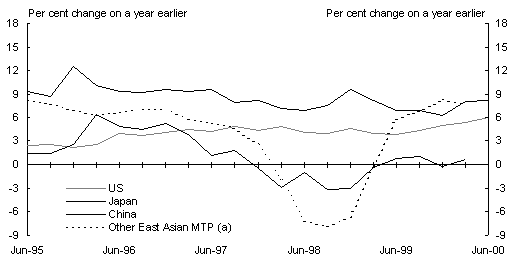
(a) Other East Asian MTP comprises Korea, Singapore, Taiwan, Hong Kong, Indonesia, Malaysia, Thailand, and the Philippines.
GDP weights are based on purchasing power parity.
Source: Various national statistical publications, IMF and Treasury.
Over the past few months, exchange rates and stock markets have weakened in several countries, such as Indonesia and the Philippines. This probably reflects a combination of factors, including lower interest rates relative to the United States, concerns in financial markets about the pace of financial and corporate sector reforms, and political instability.
Growth in Europe strengthened considerably in the first half of 2000. The stronger growth was broadly based with private consumption, investment and exports all improving. The external sect
or has benefited from improved world growth and a competitive Euro. While the outlook for Europe remains positive, there is some risk that the strong growth in the region could lead to higher inflation outcomes and further tightening of monetary policy.
Domestic Economic Activity
Economic activity has remained strong in recent quarters with GDP growth of 1.1 per cent in the March quarter and 4.3 per cent in through-the-year terms. The outcome for the year to the March quarter indicates that the Budget forecast of 4 per cent GDP growth in 1999-2000 is readily achievable.
On the expenditure side, in the March quarter both dwelling and business investment accelerated strongly with growth in household consumption moderating. Solid employment growth and strong growth in company profits contributed to robust growth in the income-based measure of GDP while growth in the mining, construction, and agriculture, forestry and fishing sectors contributed to healthy growth on the production side.
Growth is expected to have continued at a solid rate in the June quarter. The partial data point to strong growth in retail trade, at least partly reflecting very strong growth in the month of June ahead of the changed indirect tax arrangements. Robust employment growth in the June quarter is also likely to be indicative of underlying strength in activity.
Looking further ahead, Australia’s growth in 2000-01 is forecast in the Budget to be 3 per cent, with moderating growth in domestic demand partially offset by the beneficial impact on Australia’s net exports from the continued recovery of the world economy and the lower exchange rate.
Private Consumption
Recent partial indicators for private consumption suggest a slight moderation in growth after several very strong years. Current price retail trade rose by 7.7 per cent in June (seasonally adjusted), after rising by 0.3 per cent in May and by 0.1 per cent in April. The increase in June is the largest monthly increase since the retail trade survey began in 1962 (Chart 3). However, much of the large rise recorded in June is likely to be attributable to some shifting in the normal consumption patterns due to the changes to indirect tax arrangements. Leaving aside the June outcome, trend growth in retail sales has slowed significantly since late 1999.
Chart 3: Retail Trade
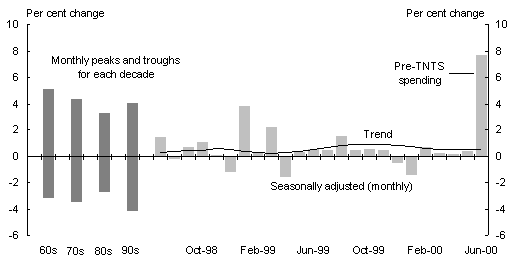
Source: ABS Cat. No.8501.0
Buoyed by the strong outcome in the month of June, the volume of retail trade rose by 2.7 per cent in the June quarter (seasonally adjusted) following a fall of 1.4 per cent in the March quarter. While trend growth in retail trade turnover since late 1999 has been subdued, household spending on services and other ‘non-retail’ items remained strong in the March quarter with the volume of consumption of these items rising 1.6 per cent (seasonally adjusted). To date, there is limited partial data available on household spending on services in the June quarter. However, relative price changes associated with tax reform seem likely to have encouraged some bring-forward of spending on services into the June quarter.
Motor vehicle registrations fell 15.2 per cent in June, to be 23 per cent lower than a year ago. However, similar to retail trade, the timing of motor vehicle purchases is likely to have been affected by the changes to the indirect tax arrangements. These changes are likely to have resulted in a deferral of motor vehicles purchases into the second half of 2000. Preliminary data from the Federal Chamber of Automotive Industries indicates that sales of new passenger vehicles rose by more than 50 per cent in July (in original terms), and were more than 30 per cent higher than July 1999.
After falling around 16 per cent between January and May, the Westpac-Melbourne Institute Survey of Consumer Sentiment index rebounded strongly in June, July and August to be at its highest level since November 1999 (Chart 4). Responses to questions relating to family finances and the economic outlook have become much more optimistic, suggesting any uncertainty surrounding the implementation of The New Tax System has largely dissipated.
Chart 4: Westpac-Melbourne Institute Survey
of Consumer Sentiment index
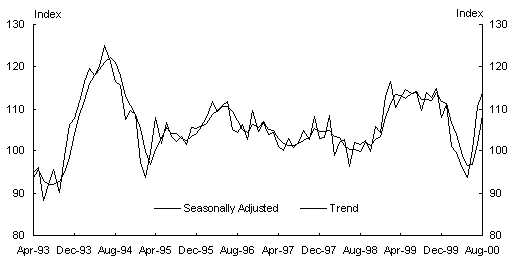
Source: Westpac-Melbourne Institute Survey of Consumer Sentiment (various issues).
Private Investment
New business investment, which abstracts from the purchase of second hand assets from the public sector, rose 6 per cent in the March quarter to be 0.5 per cent lower than a year ago. Investment in new plant and equipment jumped 10 per cent in the quarter, continuing the saw-tooth pattern of recent years, and is 4 per cent higher than a year ago (Chart 5). Investment in intangible fixed assets (predominantly software and mineral exploration) rose 6 per cent in the quarter, to be 22 per cent higher than a year ago, continuing the very rapid growth seen over the past decade (Chart 6). In contrast, investment in new non-residential construction fell a further 3 per cent in the quarter and has now fallen 10 percent over the past year.
These outcomes are broadly in line with the Budget forecast for solid growth in business investment in 1999-2000 as a whole.
Chart 5: Quarterly growth in
plant and equipment investment
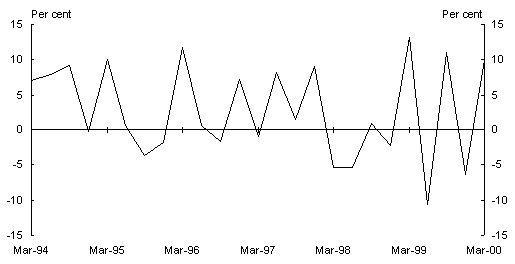
Source: ABS Cat. No.5206.0
Chart 6: Investment in intangible fixed assets
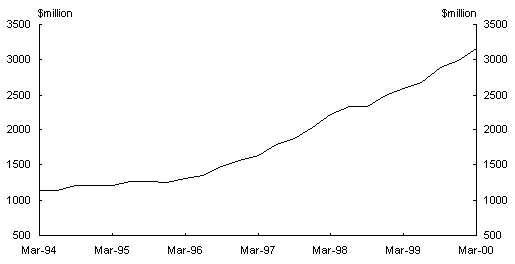
Source: ABS Cat. No.5206.0
The most recent ABS Private New Capital Expenditure (CAPEX) Survey reported that business investment intentions for 2000-01 were around 7 per cent higher than the corresponding estimate in the previous year. These early readings on investment intentions, which were taken in April and May, have historically provided only a broad, impressionistic guide to likely outcomes. Moreover, there is greater than usual uncertainty in mapping these nominal spending plans into spending in real terms because of the likely falls in investment prices, particularly for plant and equipment, as a result of the introduction of The New Tax System. The ABS have indicated that the majority of businesses have been unable to report expected expenditure based on prices under The New Tax System because businesses’ capital expenditure budgets are not sufficiently detailed at this stage to take account of expected price changes.
The value of non-residential building commencements and the amount of work in the pipeline have both trended down over the past two years. This follows several years of strong growth in spending, partly related to the Olympics and a period of very strong investment in the mining sector.
That said, the most recent data suggest a more positive outlook for non-residential construction particularly over the medium term. The value of non-residential building approvals has recently picked-up from earlier lows to
be around the average level of recent years (Chart 7). In addition, the value of engineering commencements rose to be close to the highest level of the past few years, in part reflecting the commencement of work on the West Angelas iron ore project. Strong world economic growth, rising commodity prices and firmer share prices for resource companies should provide some support to the outlook for mining investment.
Chart 7: Private non-residential building approvals
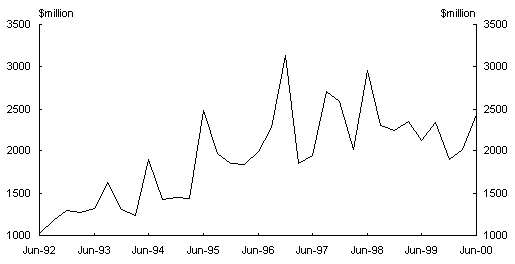
Sources: ABS Cat. No. 8731.0
Overall, the recent investment intentions and partial data, together with healthy profit levels, firm rates of capacity utilisation and continued strong economic growth, point to solid investment growth in 2000-01. A further decline in non-residential construction is likely to be more than offset by strong growth in spending on plant and equipment and intangible fixed assets.
Recent business surveys have reported that measures of business confidence have been declining: in some surveys confidence has fallen to the levels reached during the Asian financial crisis. That said, the loose nature of the historical relationship between measures of business confidence and overall economic growth was discussed at length in the Winter 1998 edition of the Economic Roundup. It is noteworthy, for example, that some survey measures of business confidence and business conditions weakened significantly in 1998, during the Asian financial crisis, at a time when overall economic growth continued at a solid pace (Chart 8).
Chart 8: Business confidence and non-farm GDP
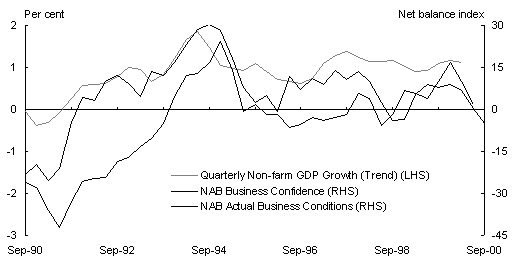
Sources: ABS Cat. No.5206.0; National Australia Bank Quarterly Business Survey, June quarter 2000.
Dwelling investment grew strongly in the March quarter, by 10 per cent, and by 13.8 per cent in the year to the March quarter. In part this reflects a net bring-forward of activity ahead of the changed indirect tax arrangements under The New Tax System.
An unwinding of this bring-forward of dwelling investment into 1999-2000 is widely expected to result in a decline in housing activity in 2000-01. Recent leading indicators of housing activity are consistent with such a decline, particularly in the latter part of the 2000-01 financial year (Chart 9). Private sector dwelling approvals fell by 21.5 per cent in June, following a fall of 4.6 per cent in May, and finance approvals for new dwellings have fallen 30.8 per cent in the year to June. However, it is likely that dwelling investment will remain at a high level in the early part of 2000-01 due to the beneficial impact of the First Home Owners Scheme, and as some pre-GST construction activity slips into 2000-01.
Chart 9: Indicators of dwelling investment
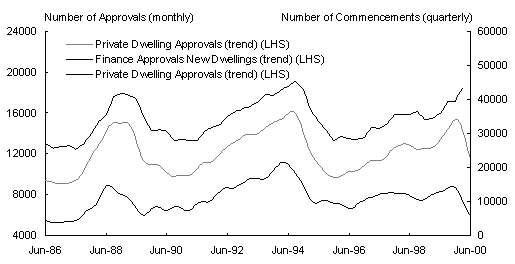
Source: ABS Cat. Nos. 5609.0, 8731.0, 8750.0
Labour Market
In 1999-2000, employment grew by a strong 2.7 per cent (or around 240 000 persons) in year-average terms. Approximately two-thirds of the increase was in full-time employment.
An acceleration in employment growth in the latter half of 1999-2000 is likely to have contributed to the strong rise in labour force participation over this period (ie the ‘encouraged worker’ effect). Labour force participation averaged 63.7 in the June quarter 2000, up from 63.0 in the June quarter 1999 and 63.3 in the December quarter 1999.
Despite the increase in the labour force, ongoing employment growth was sufficient to produce a steady decline in unemployment over the year. The unemployment rate in June 2000 (6.6 per cent) was down from 7.2 in June 1999.
Increasingly the benefits of ongoing employment growth are being shared amongst teenage and long-term unemployed. The number of unemployed fell by around 57 000 in year-average terms, with a decline of around 40 000 in long-term unemployment. The proportion of long-term unemployed to total unemployment in 1999-2000 (28.7 per cent in year-average terms) was at its lowest since the 1990–91 financial year while teenage unemployment continued to decline, falling to its lowest level (21.9 per cent in year-average terms) in a decade.
In seasonally-adjusted terms, total employment rose by almost 76 000 in July, following a strong rise in June. The unemployment rate declined to 6.3 per cent in July in seasonally-adjusted terms, the lowest level since April 1990. Abstracting from the volatility inherent in the monthly seasonally adjusted data, trend employment rose by around 24 000, with the unemployment rate drifting down to 6.5 per cent.
The broad distribution of growth amongst the States and Territories suggests that the large rise in July, particularly the concentration in part-time jobs, was not necessarily Olympics related, but indicative of broader-based demand for labour.
The various job vacancy series remain around historical highs, with the underlying trends in these series pointing to ongoing solid employment growth in trend terms over the months ahead (Chart 10).
Chart 10: Job vacancies and trend employment growth
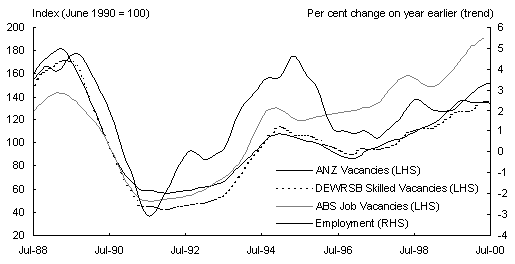
Sources: ABS Cat. Nos. 6203.0, 6354.0; DEWRSB Skilled Vacancy Series; ANZ Job Advertisements Series
The ANZ job advertisement survey recorded a modest fall in the number of jobs advertised in the major metropolitan newspapers in both June and July (albeit from decade highs). Nevertheless, current levels of job advertisements are still consistent with healthy employment growth over the next few months. Moreover, the ANZ cautions that the means by which employees are recruiting may be changing and this could be reflected in some substitution away from traditional newspaper advertisements to increased utilisation of the internet. Although not directly comparable with the newspaper job advertisement series, the ANZ’s measure of internet job advertisements increased by more than 50 per cent through the year to July 2000.
Wages
Taken together, the range of available measures indicates that wages growth remains moderate. While some recent data suggest that wages growth may have started to increase from a low base in response to a gradual tightening of the labour market, this trend is yet to be confirmed by the full range of wage indicators.
Preliminary average weekly ordinary time earnings (AWOTE) grew by 4.5 per cent in the year to the June quarter, up from 4.1 per cent in the year to the March quarter. Average earnings on a national accounts basis (AENA) grew by 3.8 per cent in the year to the March quarter. While these measures suggest wages growth has increased from the lows recorded in the second half of 1999, both series can be volatile and are subject to compositional effects which make it difficult to determine the extent of any upward pressures.
Other wage indicators are still pointing to wages growth and bargaining outcomes that are relatively steady. The wage cost index, which attempts to control for compositional effects, grew by 2.8 per cent in the year to
the March quarter, the lowest result in the short history of the index. Federal enterprise agreements ratified in the March quarter contained average annual wage increases of 3.4 per cent for the employees covered by those agreements. This is in line with the wage outcomes contained in agreements ratified in earlier quarters. In the second half of 2000, a significant proportion of existing agreements will expire, covering an estimated 28 per cent of private sector employees on enterprise agreements. This proportion is higher than usual, partly reflecting common expiry dates in the metals manufacturing and construction industries.
As noted in the Budget, there is no rationale for higher wages to ‘compensate’ for price effects resulting from changes to indirect tax arrangements under The New Tax System. There continues to be no evidence of widespread inclusion of inflation-related clauses in new enterprise agreements.
Prices
In line with Budget forecasts, the Consumer Price Index (CPI) increased by 3.2 per cent in the year to the June quarter 2000. While above recent outcomes, the through-the-year increase was influenced by a number of one-off factors, indicating that ongoing inflation is running at significantly lower levels.
World oil prices increased by more than 60 per cent in US dollar terms over the year to the June quarter, leading to a sharp rise in petrol prices in most countries. In Australia, the increase in petrol prices was around 22 per cent over the past year. Leaving aside petrol prices, the CPI rose by 2.4 per cent over the past year, well within the Reserve Bank’s medium-term inflation target band.
The prices of several items are likely to have been affected to some extent over recent quarters in the lead-up to the introduction of The New Tax System. For example, house purchase prices have risen in response to very strong activity in the housing sector, insurance prices (as measured in the CPI) have included a GST component and tobacco prices have increased reflecting the move to per-stick excise taxation in November 1999. At the same time, prices of some audio, visual and computing equipment fell significantly over the past year, at least partly in response to a cut in wholesale sales tax rates on a range of items in late July 1999. Motor vehicle prices also declined slightly, by around 0.5 per cent over the past year, which may include an element of discounting ahead of the changed indirect tax arrangements on 1 July.
Leaving aside these items and petrol (which together account for around 20 per cent of the CPI basket), the remaining items in the CPI have increased in price by less than 2 per cent on average over the past year, although with some gradual acceleration evident as the year progressed.
Inflationary expectations, as measured by the Melbourne Institute of Applied Economic and Social Research, decreased significantly in July to 4.6 per cent, down from around 7 per cent in June. This fall has been sustained in August with a further 0.1 per cent fall. This outcome appears to largely reflect consumers revising down the expected price impact of the introduction of The New Tax System, with a sharp fall since June in the proportion of respondents expecting an increase in prices of 10 per cent or more.
Recent data indicate an increase in ‘upstream’ price pressures in recent quarters, such as prices of manufactured items at the factory gate, and materials used in manufacturing. This seems to largely reflect a recovery in world commodity prices, particularly oil, and the lower Australian dollar. However, such upstream price measures have had only a loose relationship with the CPI in recent years (Chart 11).
Chart 11: Producer and consumer prices

Source: ABS Cat. Nos. 6401.0, 6412.0
Current Account Balance
The current account deficit in the March quarter 2000 was $8.0 billion or around 5.0 per cent of GDP. This is similar to the outcome in the December quarter 1999 of $7.8 billion or 5.0 per cent of GDP and well below the peak of 6.1 per cent of GDP recorded in the September quarter 1999.
The March quarter saw continued growth in Australia’s exports, reflecting the continued recovery of the world economy from the effects of the Asian financial crisis. In value terms exports grew by 4.0 per cent in the March quarter, with export volumes up by 1.4 per cent and export prices up 2.5 per cent. This growth occurred despite the inclusion in the December quarter 1999 of the export of the ANZAC frigate ‘Te Mana’ (valued at around $500 million).
At the same time, there was strong growth in the level of imports in the March quarter, with the value of imports growing 3.4 per cent, reflecting growth in import volumes of 3.5 per cent, while import prices fell slightly (down 0.1 per cent). This increase occurred despite a 30 per cent fall in the volume of fuels and lubricants imports to the lowest quarterly level since the December quarter 1994.
Overall, net exports detracted around 0.5 percentage points from growth in GDP in the March quarter, as the continued growth in export volumes was outweighed by the strong rise in import volumes. Against this, the terms of trade rose 2.6 per cent per cent in the March quarter, with a strong rise in export prices (up 2.5 per cent), and a slight fall in import prices of 0.1 per cent.
The value of exports of goods and services is estimated to have increased by 6.7 per cent in the June quarter 2000. As is evident in Chart 12, the value of exports in the June quarter 2000 was 28.2 per cent higher than in the June quarter 1999.
Chart 12: Export values and volumes
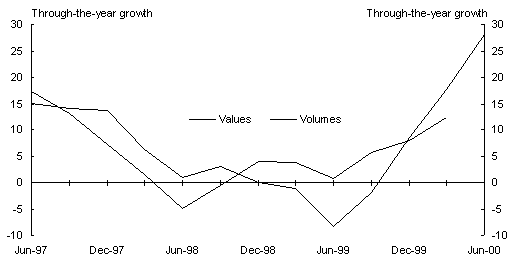
Sources: ABS Cat. Nos. 5368.0, 5302.0
The value of imports of goods and services also rose strongly, up 6.3 per cent in the June quarter 2000. This includes a 46 per cent (or $772 million) increase in the value of fuel and lubricants imports in the June quarter, suggesting higher volumes as well as higher prices (due to exchange rate depreciation and higher world oil prices).
Data on the volume of exports and imports of goods and services (and thus net exports) in the June quarter are not yet available. However, preliminary analysis by the ABS indicates that the volume of imported goods was largely unchanged in the June quarter 2000 relative to the March quarter, with import prices rising by about 7 per cent.
Commodity Prices and Terms of Trade
Since reaching their low in May 1999, in (currency neutral) SDR terms commodity prices — as measured by the Reserve Bank of Australia (RBA) commodity price index — have improved moderately through 1999-2000 to be 8.9 per cent higher in July 2000 (Chart 13). In SDR terms, rural and non-rural commodity prices have risen 11.8 and 7.4 per cent respectively over this period. Nevertheless, SDR commodity prices remain well below their pre-Asian financial crisis levels. In July 2000 SDR commodity prices were 10.7 per cent lower than in July 1997, with the rural and non-rural components around 8.9 per cent and 11.6 per cent lower respectively.
Chart 13: Reserve Bank commodity price index
Source: Reserve Bank of Australia
That said, in Australian dollar terms commodity prices are now somewhat above pre-Asian financial crisis levels. In July 2000 Australian dollar commodity prices were 8 per cent higher than in July 1997, with the rural and non-rural components 10.4 per cent and 7.0 per cent higher respectively.
The effects of the Asian financial crisis led to the significant decrease in the terms of trade. From the September quarter 1997 to the December quarter 1998, the terms of trade fell by 7.6 per cent. Subsequently, much of that fall has been reversed, with the terms of trade in the March quarter 2000 only 0.3 per cent below its September quarter 1997 level. This reflects some recovery in the foreign currency prices of exports while the foreign currency prices of imports have remained subdued.
Export Diversion – ETM Exports to Troubled Asia Recovering in 1999-2000
A key factor in the strength of the Australian economy through the Asian financial crisis was the ability of commodity exports to be diverted to other markets outside the region. However, as Elaborately Transformed Manufactures (ETMs) are more sensitive to changes in income in the importing country, Australia’s ETM exports were much more susceptible to the downturn in Asian markets. This is reflected in the significant adverse impact the Asian financial crisis has had on Australia’s ETM exports to the region. In the three months to June 1998, the value of ETM exports to the ‘troubled’ Asian economies fell by around 50 per cent compared with the corresponding period twelve months earlier (Chart 14).
Chart 14: ETM exports to
former troubled Asian economies(a)
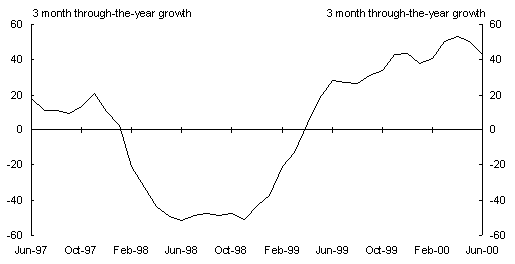
(a) ‘Troubled’ Asian economies are Indonesia, South Korea, Malaysia and Thailand.
Source: Unpublished ABS data derived from monthly trade statistics.
By the middle of 1999, as the troubled Asian economies started to recover, the value of ETM exports to the region began to rebound. In the three months to June 1999, ETM exports to the troubled Asian economies were nearly 30 per cent up over the three months ending June 1998, although still nearly 40 per cent below the outcome for the three months ending June 1997.
This recovery in ETM exports to the region gathered further pace in the 1999-2000 financial year, with the outcome for the three months ended June 2000 being over 40 per cent higher than the period ended 30 June 1999. Nevertheless, the value of ETM exports to troubled Asia in this period were still some 10 per cent lower than in the three months ended June 1997.
Net Foreign Liabilities
Net foreign liabilities as a share of GDP have grown only moderately since the Asian financial crisis, despite the resultant cyclical increase in the current account deficit (CAD) as a share of GDP. An important factor in this relatively subdued increase in net foreign liabilities compared with previous cyclical peaks in the CAD has been a significant change in the net impact of a depreciation in the Australian dollar on net foreign liabilities.
The reason for this change, as outlined in Chart 15, is that Australia’s foreign currency denominated assets now exceed our foreign currency denominated liabilities. This change reflects an increasing share of net foreign debt denominated in Australian dollars, a greater proportion of liabilities in the form of equity rather than debt (and thus denominated in Australian dollars), and an increasing level of investment by Australians in foreign equity assets.
Chart 15: Net foreign currency denominated assets
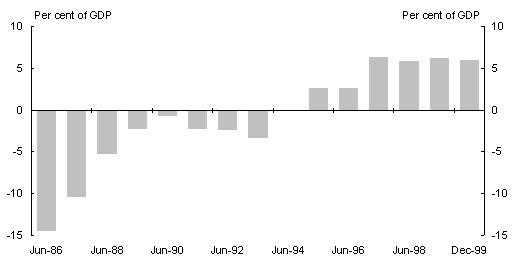
Source: ABS Cat. No. 5302.0
As a consequence, whereas previously a depreciation in the exchange rate would have led to an increase in net foreign liabilities in Australian dollars, it now leads to a moderate decrease in net foreign liabilities (Chart 16). For example, in the March quarter 2000, when the exchange rate depreciated against both the US dollar and the Trade Weighted Index, the ABS estimates that these exchange rate movements caused net foreign liabilities to be around $2 billion lower than they would have been in the absence of the currency depreciation.
Chart 16: Exchange rate impact on NFL
compared with exchange rate movements
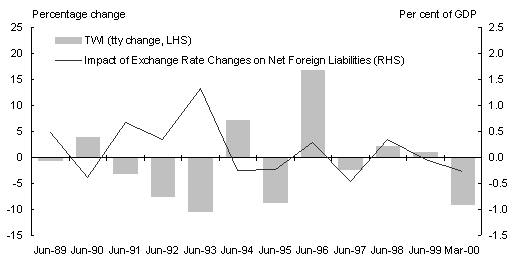
Source: ABS Cat. No. 5302.0
